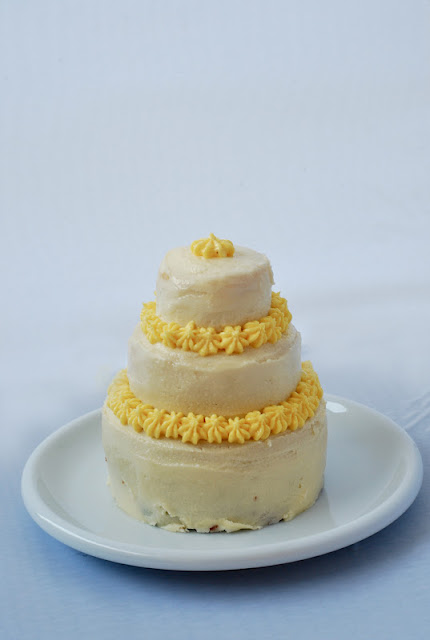This is going to get a little technical.
Most cakes call for the fat (softened butter/shortening) to be creamed with the castor sugar until it gets pale, light and fluffy before adding the liquid components (egg, milk, etc)and the dry ingredients (flour, leavening agents, salt) into the fat. The liquids and flour are added alternately.
When the sugar is blended with the fat, the crystals cut through the fat and form holes which allow air to penetrate and expand in the oven. The next step — adding the flour and liquid alternately — aids in the gluten formation in the batter which gives the cake structure. This balances out the aeration from the first step. Seems perfect, right? I don't have a problem with this common method at all. In fact I use it all the time.
So why another method? Well, not all cakes are made equal. Lets look at Beranbaum's method.
When the sugar is blended with the fat, the crystals cut through the fat and form holes which allow air to penetrate and expand in the oven. The next step — adding the flour and liquid alternately — aids in the gluten formation in the batter which gives the cake structure. This balances out the aeration from the first step. Seems perfect, right? I don't have a problem with this common method at all. In fact I use it all the time.
So why another method? Well, not all cakes are made equal. Lets look at Beranbaum's method.
Beranbaum's two-stage mixing technique kind of transposes the proses. First, you whisk not your fat and sugar BUT all the dry ingredients (flour, sugar, salt, leavening agents). Then, you add the cold and only slightly softened butter until you get a mixture that has the texture of rough sand. Then you add the liquids.You can also add a quarter of the liquid along with the butter in which case you get a slightly sticky but still sandy dough. Finally you add the remaining liquid in two or three installments.
The result is a cake that doesn't rise (less aeration) as much but is extremely tender. Almost velvety. It melts in your mouth. Literally.This method is ideal when making layered cakes. You don't want stacks that are too high, right?
Perfect for birthdays, anniversaries or just tea :)
Ricotta filled butter cake
For the cake
180g plain flour140g cake flour
1 tbsp baking powder
1/2 tsp salt
11/2 cups castor sugar
225g butter, cold and slightly softened, cut into cubes
11/4 cup milk
4 eggs
1 tbsp vanilla extract
For the Ricotta filling
200g ricotta4 tbsp icing sugar
For the buttercream
150 g butter3 cups icing sugar
2 tbsp milk
1 tsp vanilla extract
Preheat the oven to 170C. Butter and line two 9 inch pans.
Put the flours, sugar, salt and the baking powder in the bowl of your stand mixer and whisk them together (using the paddle attachment). With the mixer on low to medium, add the butter and mix until the butter is coated with the flour. The mixture should look like coarse grains of sand or tiny pebbles.
Meanwhile, beat the eggs, milk and extract together.
Add the egg mixture to the pebbled butter and flour mixture in three installments and beat only till incorporated. Don't over beat, yes?
Divide the batter into both pans and bake until set, about 30 mins (or until a tester comes out clean). Let the cakes cool in the pans for 15 mins and then transfer onto a cake rack to completely cool.
Now for the ricotta. Make sure the whey is drained from the cheese. Beat the cheese and sugar together till smooth. Remove.
Next the butter cream. Beat the butter until creamy and then add the sugar. Be careful: it may spray out of the bowl. Cream the sugar and butter until light and fluffy, adding the extract and as much milk as necessary to reach the right consistency. Set aside.
Once the cakes have cooled, remove the parchment paper and trim the tops till they're smooth. Spread the ricotta cream over the bottom layer, leaving a 1-2cm rim along the sides. Place the top layer on the cream and then ice the cake with the butter cream.
Chill. Eat. Enjoy.



.jpg)
No comments:
Post a Comment